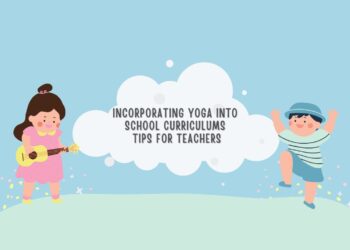Teaching yoga to children is a rewarding experience that can have a profound impact on their physical, mental, and emotional well-being. Unlike teaching yoga to adults, instructing kids requires a different approach—one that is playful, engaging, and adaptable to their unique needs and energy levels. If you’re a teacher looking to introduce yoga to your students, this guide will provide you with the tools and strategies to make the practice fun, effective, and educational.
1. Understand the Benefits of Yoga for Kids
Before diving into the “how” of teaching yoga, it’s important to understand the “why.” Knowing the benefits of yoga for children can help you tailor your lessons to meet their needs.
- Physical Health: Yoga helps children develop strength, flexibility, balance, and coordination. These physical benefits are essential for their overall growth and can support other activities like sports.
- Mental Focus: Yoga encourages mindfulness, helping children improve their concentration and focus. This can be especially beneficial in a classroom setting, where attention is key to learning.
- Emotional Regulation: Through breathing exercises and mindful movement, yoga teaches children how to manage stress and regulate their emotions. This can lead to better behavior, improved self-esteem, and a greater sense of calm.
Tip: When planning your lessons, consider how yoga can address specific challenges your students might face, such as hyperactivity, anxiety, or difficulty focusing.
2. Make Yoga Fun and Engaging
Children learn best when they are having fun. To keep them engaged, incorporate elements of play and creativity into your yoga sessions.
- Use Imaginative Play: Turn yoga poses into a story or adventure. For example, you could take the children on a “safari,” where they mimic the movements of animals they might encounter, like lions, elephants, and snakes. This not only makes the session more fun but also helps them remember the poses.
- Incorporate Games: Yoga games like “Yoga Freeze Dance” or “Animal Pose Charades” are great ways to make the practice interactive. Games encourage participation and make learning feel like play rather than a structured lesson.
- Introduce Props: Using props like colorful scarves, yoga blocks, or stuffed animals can make the practice more tangible and enjoyable. Props can also help children with alignment and balance in various poses.
Tip: Always adapt your approach based on the age group you’re teaching. Younger children may enjoy more imaginative play, while older kids might appreciate more structured challenges.
3. Focus on Short, Dynamic Sessions
Children often have shorter attention spans, so it’s important to keep yoga sessions brief and dynamic.
- Short Sessions: Start with sessions that are 15-20 minutes long, gradually increasing the duration as the children become more familiar with the practice. This prevents them from becoming bored or restless.
- Mix It Up: Vary the activities within the session to keep things interesting. Combine yoga poses with breathing exercises, mindfulness activities, and even storytelling. This variety helps maintain their focus and keeps the energy levels balanced.
- Interactive Breaks: Incorporate short breaks where children can share their thoughts or feelings about the practice. This not only gives them a mental rest but also helps them develop a deeper connection with the practice.
Tip: Pay attention to the energy levels of your students. If they seem restless, incorporate more active poses or games. If they’re tired or stressed, focus on calming poses and breathing exercises.
4. Teach Mindfulness Through Movement
Yoga is an excellent way to introduce children to mindfulness, which can help them develop better self-awareness and emotional regulation.
- Mindful Breathing: Start each session with simple breathing exercises, like “Balloon Breathing” or “Bumblebee Breathing.” Teach them to focus on their breath as a way to calm their mind and body.
- Body Awareness: Encourage children to notice how their body feels in different poses. Ask questions like, “How does your body feel when you stretch like a cat?” or “Can you feel your heartbeat in this pose?” This helps them develop a connection between their mind and body.
- Guided Relaxation: End each session with a short relaxation exercise, such as lying down in Savasana (Corpse Pose) or practicing a body scan. Use calming language and soothing music to guide them into a state of relaxation.
Tip: Mindfulness doesn’t have to be serious. Use playful language and imagery to help children understand and enjoy the concept.
5. Encourage Positive Reinforcement and Inclusivity
Creating a positive and inclusive environment is crucial for teaching yoga to children. Ensure that every child feels valued and supported in their practice.
- Positive Reinforcement: Praise children for their efforts rather than their performance. For example, say, “Great job trying that new pose!” instead of focusing on whether they did it perfectly. This encourages them to keep practicing and builds their confidence.
- Celebrate Individuality: Recognize that each child is unique, with different abilities and comfort levels. Encourage them to listen to their bodies and make adjustments as needed. Emphasize that yoga is a personal journey and that it’s okay to look different in each pose.
- Promote Inclusivity: Make sure that all children feel included, regardless of their physical abilities. Offer variations of poses so that everyone can participate in a way that feels comfortable for them.
Tip: Foster a sense of community by encouraging children to support and cheer each other on during the practice.
6. Incorporate Yoga into the Classroom Routine
If you’re teaching yoga in a school setting, consider integrating it into the daily routine rather than treating it as a separate activity.
- Morning Yoga: Start the day with a short yoga session to energize and focus the students. This can set a positive tone for the day and help them transition into learning mode.
- Yoga Breaks: Use yoga as a tool for breaks throughout the day. A few minutes of stretching or mindful breathing can help children refocus and reduce stress, leading to better concentration during lessons.
- End-of-Day Relaxation: Finish the school day with a calming yoga routine to help students unwind and reflect on the day. This can also help them transition smoothly from school to home.
Tip: Consistency is key. Regular yoga practice, even if it’s just for a few minutes each day, can have a significant impact on children’s well-being.
Conclusion
Teaching yoga to kids requires a blend of creativity, patience, and adaptability. By making the practice fun, engaging, and accessible, you can help children develop a love for yoga that will benefit them throughout their lives. Focus on creating a positive, inclusive environment where every child feels valued and supported in their yoga journey. Whether you’re incorporating imaginative play, using props, or integrating yoga into the daily routine, the goal is to make yoga an enjoyable and enriching experience for all.










